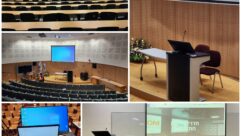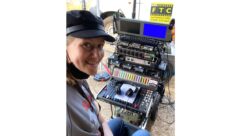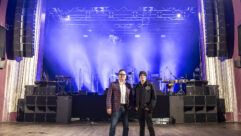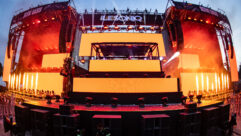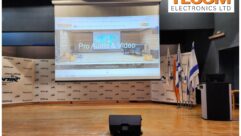THE DAYS OF SUMMER
Apr 1, 2000 12:00 PM,
Clare Climaco
Wolf Trap’s Filene Center amphitheater unveils a new, versatile soundreinforcement system for the 2000 season.
If the Kennedy Center is America’s White House for the performing arts,then Wolf Trap is its summer home. Tucked away on 130 acres (52 hectares)of rolling Virginia farmland, Wolf Trap’s pristine surroundings make it anidyllic stage for summer entertainment. The 7,000-seat Filene Center, apartially enclosed wooden amphitheater, is the centerpiece of Wolf TrapFarm Park. There, audiences can enjoy performances ranging from theNational Symphony Orchestra, the Wolf Trap Opera Company or a host of pop,country, folkand blues acts.
The Filene Center, a wooden pavilion designed to aesthetically complementthe surrounding park, attracted thousands of park visitors every year, butthe structure burned down in 1982. A temporary structure was used until thenew Filene Center was finished in 1984, the same time the house soundsystem was installed. Although the system was less than perfect, thenonprofit Wolf Trap Foundation, lacked the money to replace it. Fundingcame in 1998, and the production crew’s hope for a new, cutting-edge soundsystem was within reach.
Project scope
The amphitheater is designed to blend in with its surroundings. A roof topsthe structure built of fire-resistant Douglas fir and southern yellow pine,102 feet (31 m) tall at its highest point. The roof protects a 45 foot(13.7 m) tall proscenium opening, and sidewalls surround the 116 foot (35m) wide by 64 foot (19.5 m) deep stage. A rear wall behind the stagecontains a 30 foot (9 m) high by 40 foot (12 m) wide doorway, which istypically closed during performances.
The Filene Center is divided into two main sound systems – the housesystem, which covers about 3,800 seats under the roof, and a separate lawnsystem for 3,200 lawn seats. Although the long-term goal is to upgrade bothsystems, noted Wolf Trap production manager John Gray, installing a newsound system for the covered seating area took first priority.
Dave Heffelefinger, who has served as house engineer for more than 13years, had his eye on the L-ACOUSTICS V-DOSC system since hearing it andmixing on the system.
“I found that instead of equalizing for feedback and room anomalies,”Heffele-finger said, “I could actually EQ for the music. It took thereverberant room out of the equation. As an engineer, I could now hearthings more precisely.”
Soon after, the production team set out to seriously explore V-DOSC for thevenue. They contacted Jeffrey Cox, founder of Cox Audio Engineering,Oxnard, CA, which manufactures the French-designed V-DOSC arrays for NorthAmerica. Cox, brought in veteran system designer Patrick Baltzell. The teamdiscussed the system’s goals.
Cox said, “I wanted to provide nothing less than the best possible systemfor the wide variety of world-class artists and entertainment presentedthere.”
“Our old system wasn’t focused tightly enough,” Gray said. “We wanted toreduce the splash on the internal surfaces of the venue and provide evencoverage for every seat in the house, which is difficult because of thewidth of the seating area. We also wanted to eliminate the lobes and nullsassociated with a multi-source system by using as close to a single-sourcesystem as possible.
“It’s a performing arts house. The events there, operas, danceperformances, symphonies and some pop acts, don’t require high SPLs. Whatwe did need was high articulation, clarity and coverage for the gamut ofevents.”
Heffelefinger described his vision for an all-encompassing, three-channelleft-center-right system that would bring the venue an unprecedented levelof sound coverage and clarity. The plan was presented to the productionteam, but when costs were a bit over budget, they decided to explore atwo-channel stereo system that could allow future expansion. Baltzell thendesigned a system that provided complete coverage from the two mainclusters.
“The design would have worked better if it had been three channels; thecoverage would have been perfect everywhere,” Baltzell said. “But theproblem was that it also increased the cost by a third. So from that, I hadto massage everything a bit, add fill speakers on the sides, and thatworked.”
Design challenges
Baltzell completed the system design on paper, and in March 1999, hevisited the venue to start planning where the arrays would actually hang.According to him, that is where the fun started.
“There’s always a struggle when you’re putting up boxes. Some people wantthem up and away, out of sight,” he said, “but sound-wise, that’s not thebest way to go. The system just sounds better when they’re down and closerto the audience. It’s aconstant battle.”
Baltzell’s original design called for the clusters to hang about 32 feet(9.8 m) from the bottom of the array to the stage, but two obstaclessurfaced that had been unknown to Baltzell during the design phase.
“I went from old drawings where the clusters were hanging about 32 feetfrom the stage, so I assumed that’s where I could hang the VDOSC,” he said,”but at some point, the clusters were moved farther apart and higher tosolve certain problems.”
Those problems involved a fixed lighting booth, hanging wooden acousticalpanels and a display screen, which is mounted over the stage to show operatranslations. Baltzell had to adjust the left-right position of theclusters to avoid blocking a spotlight that is used to guide performers onand off stage. Two 10 foot (3 m) wide circular wooden acoustical panels,which hang above the stage, were quickly removed to make way for theclusters. The display screen proved to be another obstacle.
“The opera scenery is tall and grand, and the screen has to be above thescenery,” Baltzell said. “So you’re now imposing an impossible trim andseverely limiting how low the clusters could be hung. So we ended up havingto raise the speakers substantially, like 5 feet (1.5 m) or 6 feet (1.8 m)more than what we had originally designed them for.”
Moving the clusters up and farther apart, Baltzell said, introduced somewrinkles into the original design.
“Originally when I had just the mains all in a line, I didn’t need speakersanywhere else except for sidefills to hit the areas that I couldn’t hitwith two clusters. I didn’t need under-balcony speakers, but when we movedthe clusters up, the balcony shadowed the back orchestra level rows.”
Each main array is made up of 10 rectangular V-DOSC boxes or elementsstacked in a line array. Each element contains two 15 inch (381 mm) directradiating cones, four 7 inch (178 mm) kevlar cones arranged in a V-shapedflare, and two 2 inch (51 mm) compression drivers mounted onto theproprietary DOSC waveguide. When properly arrayed, the configurationcreates a cylindrical wavefront with a 90 degree horizontal dispersion,resulting in seamless sound emanating from a single source.
The two arrays cover five zones in the venue. The top four elements in eacharray cover the seats in the balcony. By minimizing the angle between theupper array boxes, the coupling of the high frequencies, the length of thethrow and the single point source effect are maximized. The six additionalelements in the arrays can be seen as two sets of three elements. Elementsfive through seven (counting from the top element as number one) are aimedat orchestra-level rows 19 through 29, while the lowest three V-DOSC boxes(eight through 10) are angled to cover orchestra level rows 11 through 18.The L- ACOUSTICS ARCS loudspeakers (a two-way loudspeaker that, using theDOSC waveguide, arrays horizontally) are presently located just below thecluster to provide near-range coverage for rows three through 10. Twoadditional ARCS per side are hung from trusses for side-fill. TwoL-ACOUSTICS MTD108s, single 8 inch (203 mm) loudspeakers with 1 inch (25.4mm) drivers, are mounted on the front lip of the stage for front-fill. Theunder-balcony seats (orchestra-level rows 29 through 35) are presentlycovered by previously existing loudspeakers, but they will be replacedbefore the 2000 season begins. Also, 21 QSC PowerLight 6.0 superscript PFCsprovide up to 63,000 W for the main clusters.
Four L-ACOUSTICS SB218 subwoofers (two 18 inch or 457 mm loudspeakers each)per side were built into two wooden enclosures and flown 8 feet (2.4 m)from the stage on each side of the proscenium wall. The subs are driven bya pair of PowerLight 9.0 superscript PFCs with two subs running off one ampchannel. Each amp channel offers 4,500 W into 2 V.
Wolf Trap sound department head William Valentine said, “The Power-Lightsare quiet and clean. They have a transparent sound with an airy low-end.The PowerLights also proved to be practical. Installation was a breeze.Now, we have half as many amps with six times more power.”
Results
The new system has solved the uneven coverage, room reverberation, andlobes and nulls that had plagued the previous, 15-year-old system.
“Previously, we had the problem of multiple zones hitting each person inthe audience,” Valentine said. “The best seats in the house were being hitby five different sound point-sources, with the result being that coherencewas sacrificed for volume and frequency distribution. Now, the coverage ismore even than it’s ever been. It is very coherent.”
The L-ACOUSTICS wavefront concept also helped minimize reverberation andoptimize room acoustics. The venue was originally designed to bereverberant to complement piano, guitar and vocal acts, and the teamconsidered covering all the hard surfaces with acoustical treatments.
“But the cost got prohibitive and the options weren’t aestheticallypleasing,” Valentine said. “After we installed V-DOSC, we found that thebaffling became unnecessary. We got the V-DOSC to focus the sound off thewalls. This system reduces reverb time for all frequency bands, especiallythe mid- and high-frequency ranges. Measuring with an empty room, ourprevious RT subscript 60 was 1.8 seconds. V-DOSC reduced that to 1.3seconds, and that reduces by half again when the house is full.”
The Filene Center itself is located on a border and just beyond the park’sedge are private homes. A tighter-sounding system has meant that shows moreconsistently meet the 95 dB house limit, reducing complaints from neighbors.
“We put a lot of time and effort into selecting a new system for thisvenue, and the result is worth it. We enjoy even coverage throughout thehouse and far fewer complaints from the audience and neighborhood,” saidGray.
FOH and monitors
The house mix position, located midway and slightly to the right of theorchestra area’s center section, is equipped with a Yamaha PM4000-48C,which offers 48 available input channels, eight VCA masters, eight groupmasters, eight auxiliary busses, and an 11 8 mix matrix. An Allen & HeathSC-416XA 16-in/4-out matrix is also available as an auxiliary desk. Newoutboard components installed last summer also include XTA DP 226processors and remote-controllable BSS Varicurve system EQs. The XTAprocessors each have two ins and six outs that provide system-wide DSPfunctions in a 1 RU box. Each input has gain, delay and eight bands ofparametric control, while each output consists of a high- and low-passfilter, five bands of parametric EQ, and limiter, delay, gain and polaritycontrols.
“When they did the original installation more than 15 years ago, theydidn’t have the all-in-one boxes, so we had the EQ, the crossovers, and allUrei LA-4 compressors at the end of the chain before the signal hits theamplifier. Prior to the new XTA processors, we were using BSS Omnidrives,which did away with all of the individual components in the signal chain.Now, we have about 30 or so Urei LA-4s lying around, so I now have severalat the house mix position. I love using them, and many visiting engineersare pleased to see them.”
System equalization is handled by Klark-Teknik DN 405 parametric EQs inevery zone. In addition to the Klark-Tekniks, remote-controllable BSSVaricurve FCS-926 dual EQs are also used, allowing freedom and convenienceof correcting EQ from anywhere in the facility. Other house outboard gearincludes 18 Valley People compressor/limiters and expander/noise gates, aTC Electronics M5000 for effects processing, Yamaha SPX digital processorsand a Lexicon PCM-70.
Audio patching remained unchanged since the original installation. Withmore than 4,000 audio patch points available, the system remains flexible.Mic inputs, tie lines and loudspeaker lines are available throughout thetheatre. All mics are routed to 1-in/4-out active mic splitters. Splitteroutputs are routed to the house, lawn and onstage mixing consoles. A sparesplitter is available for touring acts or for recording and television usesa,s are tie lines between the stage and all mixing consoles.
The Filene Center stage monitor system primarily consists of Meyer UM-1 andElectroVoice Delta Max DML215 wedges driven by a slew of QSC Series Threeamps. The monitor mix position uses a RAMSA S-840F console equipped with 40mic inputs and 18 discrete outputs. Processing gear – 15 Digitech MEQMono-28 EQs, three Urei LA4 compressors and a Yamaha SPX 90 digitalprocessor – are mounted in a rack that contains a TRS patchbay, providingaccess to all 69 mic splitters, along with stage, house and lawn lines. Italso provides access to all inputs, outputs, break points and any outboardequipment.
This new system will be fine-tuned over the 2000 season. Six newL-ACOUSTICS dV-DOSC loudspeaker elements, a compact, full-range, two-wayenclosure that also uses the DOSC wave-guide, will replace the existingARCS as downfill below the mains. Additional pairs of dV-DOSC will alsoreplace the delay loudspeakers under the balcony as specified in theoriginal plan.
“In the past, visiting engineers would try to compensate for the fact thatthey had to use the house system by cranking up the SPL, but that wouldmuddy the sound and boost the SPL beyond the 95 dB house limit,” Gray said.”Now, they are quite interested in mixing on our system, and the engineersget a tighter, more focused sound without cranking it up.”


